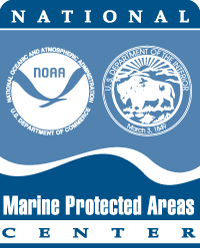Olympic Coast National Marine Sanctuary's Intergovernmental Policy Council
A Resource by the Marine Protected Areas Federal Advisory Committee (These statements do not necessarily reflect the positions of NOAA or the U.S. Government)

The Olympic Coast National Marine Sanctuary (OCNMS) is a large MPA of approximately 2,500 square miles adjacent to the Olympic Peninsula of Washington State encompassed by the treaty ocean areas of four coastal tribes: The Makah, Quileute and Hoh Tribes and the Quinault Indian Nation. Each of these tribes was instrumental in the designation of the OCNMS in 1994. The designation Charter clearly noted that the new Sanctuary would in no way interfere with treaty harvest of fisheries resources within that area.
Prior to 2007, tribal representation consisted of participation on the Sanctuary Advisory Council (SAC), a stakeholder group representing various governments and interests in the Sanctuary area. In 2000, the SAC formed a Marine Conservation Working Group (MCWG) to identify areas of biological importance on the OCNMS shoreline. The OCNMS contracted a scientist to walk the shoreline of the Sanctuary and describe intertidal habitats and species present. Results were brought to the MCWG regularly where they were examined by representatives from the SAC, including some tribal technical staff. In March 2001 the MCWG formed a Technical Panel of experts to meet at the University of Washington and examine the coastline data. At that meeting, they created recommendations for "Proposed No-Take Marine Reserve Areas" specific to sections of the coast considered biologically important or unique. No tribal representation was invited to or present at that workshop.
At a public meeting held shortly after, maps were displayed of the Olympic Peninsula coast that highlighted areas proposed for no-take status as determined by the Technical Panel. These included a number of areas within the reservation boundaries of the Quinault Indian Nation and the Hoh, Quileute and Makah Tribes, all of which were important commercial or subsistence harvest areas.
Presenting maps showing proposed no-take areas within their reservation and off-reservation treaty harvest areas without proper consultation was a major concern to the tribes involved with this case. A contractor surveying their respective reservation coastlines without tribal permissions was also another significant issue.
Repercussions of these actions by the OCNMS lasted over five years as the coastal tribes and NOAA conducted a series of meetings and legal reviews to fulfill the federal government' trust responsibilities with the treaty tribes. In January 2007 the four coastal treaty tribes, the State of Washington and NOAA formally created the Intergovernmental Policy Council (IPC), a policy-level forum for the co-managers of the resources within the boundaries of the OCNMS.
The IPC is now the primary forum for OCNMS-Tribal interaction. It does not, however, replace individual tribal government-to-government consultation when requested. The successful resolution of this issue by NOAA’s Office of National Marine Sanctuaries serves as an example for other federal agencies. The creation of the IPC with its commitments from tribal governments, state government and NOAA is a potential model for other regions where MPAs and their management intersect with tribal and indigenous sovereignty.
The lessons of this case study are:
- Tribes are not best represented in "stakeholder" forums. They are sovereigns and, in many cases, resource managers with a depth of knowledge and experience about MPAs that needs to be included in studies and decisions about the marine resources associated with them.
- Managers must identify proper tribal representatives to inform and consult with on a regular basis. It is incumbent on managers to contact tribal leadership to determine with whom they should engage.
- Tribes should have open invitations to attend workshops related to projects that may affect them, and be invited to present and share knowledge at these events.
- Technical representation by tribes is not policy representation and it should not be assumed that because technical staff is advised, tribal leadership is.
- A rule of tribal consultation is best summarized as "early and often." To avoid breaches of trust that may take years to mend, consult early and often.
- Coordination and communication should take place on a regular basis, whether an undertaking is identified or not
- Creation of policy level forums with tribal representation, distinct from stakeholder groups, will foster trusted relationships and avoid potential conflicts.
 Marine Protected Areas
Marine Protected Areas